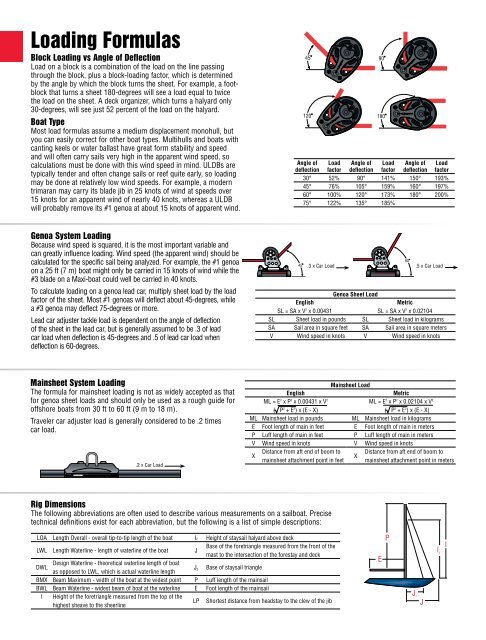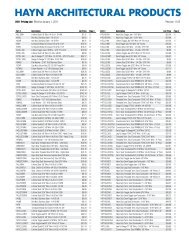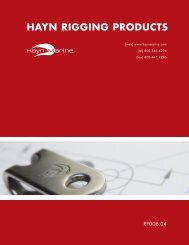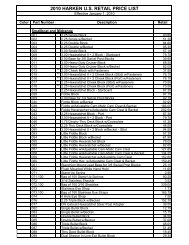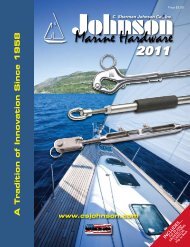2009 - 2010
Harken_Catalogue_201.. - Kansas City Sailing
Harken_Catalogue_201.. - Kansas City Sailing
- No tags were found...
You also want an ePaper? Increase the reach of your titles
YUMPU automatically turns print PDFs into web optimized ePapers that Google loves.
Loading Formulas<br />
Block Loading vs Angle of Deflection<br />
Load on a block is a combination of the load on the line passing<br />
through the block, plus a block-loading factor, which is determined<br />
by the angle by which the block turns the sheet. For example, a footblock<br />
that turns a sheet 180-degrees will see a load equal to twice<br />
the load on the sheet. A deck organizer, which turns a halyard only<br />
30-degrees, will see just 52 percent of the load on the halyard.<br />
Boat Type<br />
Most load formulas assume a medium displacement monohull, but<br />
you can easily correct for other boat types. Multihulls and boats with<br />
canting keels or water ballast have great form stability and speed<br />
and will often carry sails very high in the apparent wind speed, so<br />
calculations must be done with this wind speed in mind. ULDBs are<br />
typically tender and often change sails or reef quite early, so loading<br />
may be done at relatively low wind speeds. For example, a modern<br />
trimaran may carry its blade jib in 25 knots of wind at speeds over<br />
15 knots for an apparent wind of nearly 40 knots, whereas a ULDB<br />
will probably remove its #1 genoa at about 15 knots of apparent wind.<br />
Angle of<br />
deflection<br />
Load<br />
factor<br />
Angle of<br />
deflection<br />
Load<br />
factor<br />
Angle of<br />
deflection<br />
Load<br />
factor<br />
30° 52% 90° 141% 150° 193%<br />
45° 76% 105° 159% 160° 197%<br />
60° 100% 120° 173% 180° 200%<br />
75° 122% 135° 185%<br />
Genoa System Loading<br />
Because wind speed is squared, it is the most important variable and<br />
can greatly influence loading. Wind speed (the apparent wind) should be<br />
calculated for the specific sail being analyzed. For example, the #1 genoa<br />
on a 25 ft (7 m) boat might only be carried in 15 knots of wind while the<br />
#3 blade on a Maxi-boat could well be carried in 40 knots.<br />
To calculate loading on a genoa lead car, multiply sheet load by the load<br />
factor of the sheet. Most #1 genoas will deflect about 45-degrees, while<br />
a #3 genoa may deflect 75-degrees or more.<br />
Lead car adjuster tackle load is dependent on the angle of deflection<br />
of the sheet in the lead car, but is generally assumed to be .3 of lead<br />
car load when deflection is 45-degrees and .5 of lead car load when<br />
deflection is 60-degrees.<br />
.3 x Car Load .5 x Car Load<br />
Genoa Sheet Load<br />
English<br />
SL = SA x V 2 x 0.00431<br />
Metric<br />
SL = SA x V 2 x 0.02104<br />
SL Sheet load in pounds SL Sheet load in kilograms<br />
SA Sail area in square feet SA Sail area in square meters<br />
V Wind speed in knots V Wind speed in knots<br />
Mainsheet System Loading<br />
The formula for mainsheet loading is not as widely accepted as that<br />
for genoa sheet loads and should only be used as a rough guide for<br />
offshore boats from 30 ft to 60 ft (9 m to 18 m).<br />
Traveler car adjuster load is generally considered to be .2 times<br />
car load.<br />
.2 x Car Load<br />
Mainsheet Load<br />
English<br />
Metric<br />
ML = E 2 x P 2 x 0.00431 x V 2<br />
( P 2 + E 2 ) x (E - X)<br />
ML = E 2 x P 2 x 0.02104 x V 2<br />
( P 2 + E 2 ) x (E - X)<br />
ML Mainsheet load in pounds ML Mainsheet load in kilograms<br />
E Foot length of main in feet E Foot length of main in meters<br />
P Luff length of main in feet P Luff length of main in meters<br />
V Wind speed in knots V Wind speed in knots<br />
X<br />
Distance from aft end of boom to Distance from aft end of boom to<br />
X<br />
mainsheet attachment point in feet mainsheet attachment point in meters<br />
Rig Dimensions<br />
The following abbreviations are often used to describe various measurements on a sailboat. Precise<br />
technical definitions exist for each abbreviation, but the following is a list of simple descriptions:<br />
LOA Length Overall - overall tip-to-tip length of the boat I2 Height of staysail halyard above deck<br />
LWL Length Waterline - length of waterline of the boat J<br />
Base of the foretriangle measured from the front of the<br />
mast to the intersection of the forestay and deck<br />
DWL<br />
Design Waterline - theoretical waterline length of boat<br />
as opposed to LWL, which is actual waterline length<br />
J 2 Base of staysail triangle<br />
BMX Beam Maximum - width of the boat at the widest point P Luff length of the mainsail<br />
BWL Beam Waterline - widest beam of boat at the waterline E Foot length of the mainsail<br />
I Height of the foretriangle measured from the top of the<br />
highest sheave to the sheerline<br />
LP Shortest distance from headstay to the clew of the jib<br />
E<br />
P<br />
J 2<br />
J<br />
I 2<br />
I<br />
28


